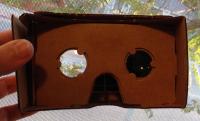Steroscopic Model Views
Submitted by Leonard Daly on Tue, 04/21/2015 - 12:03 |
| Credit: Runner1928. Details |
 |
| Credit: Runner1928. Details |
 Smart phones and tablets with recent releases of Chrome, Firefox, Safari, or Internet Explorer can display 3D models from the Web. These devices also have internal sensors that tell the browser about its orientation.
Smart phones and tablets with recent releases of Chrome, Firefox, Safari, or Internet Explorer can display 3D models from the Web. These devices also have internal sensors that tell the browser about its orientation.
Maya is used for a lot of 3D modeling. Modelers frequently save their completed work in a FBX file. FBX is a proprietary format designed by Autodesk (check this). In addition to the model, it contains the textures, rigging, and animation. It is a very convieient format, if you have an appropriate library of other tool to unpack it. Blender is an open-source modeling program. There is an FBX importer in Blender that handles many of the features and variations of the FBX format.
"Creating 3D Scenes for the Browser", a presention to Digital Designers Los Angeles and Digital Media Artists Los Angeles on 20 Jan 2015. The PDF of the presentation with slides and notes is available. This is the final version.
The presentation focuses on the capabilities and reasons for using X3D for Serious VR & 3D graphics .
 Getting X3D to display on your webpage is very simple. The simpliest example can be accomplished in three easy steps. These are summarized as
Getting X3D to display on your webpage is very simple. The simpliest example can be accomplished in three easy steps. These are summarized as
In a previous post I showed how a scene could be displayed in a browser and viewed stereoscopicly with Google Cardboard. This post describes a more efficient means of creating the display. In both cases, the browser screen is split in half with slightly different viewpoints so the eyes/brain combination views the result with depth.
This post expands on the presentation titled "Driving the Evolution of the 3D Web". The code is include plus active links to the demos and examples.
The groundwork for the display of 3D graphics and 3D stereographics using the web has been laid. Head-mounted displays such as Google Cardboard and Oculus Rift now make it possible to view stereoscopic scenes in your home or out on the street.
X3D is the international standard for web-based 3D graphics. The Web3D Consortium has identified X3DOM (http://x3dom.org/) as the prototype example implementation for V4. Below are links to various presentations on X3D/X3DOM.
Copyright © 2025, Daly Realism
Theme by Zymphonies
